Croydon War Hospital
Davidson Road School, Croydon, Surrey CR0 6DD
Ecclesbourne Road School, Thornton Heath, Surrey CR7 7BN
Ingram Road School, Thornton Heath, Surrey CR7 8DZ
Stanford Road School, Norbury, SW16 4QA
The Crescent Schools, Croydon, Surrey CR0 2HN
Ecclesbourne Road School, Thornton Heath, Surrey CR7 7BN
Ingram Road School, Thornton Heath, Surrey CR7 8DZ
Stanford Road School, Norbury, SW16 4QA
The Crescent Schools, Croydon, Surrey CR0 2HN
Medical dates:
Medical character:
Military
The
Croydon War Hospital consisted of five divisions, namely the Council
School buildings in Davidson Road, Ecclesbourne Road, Ingram Road,
Stanford Road and the Boys' and Girls' Secondary Schools in The
Crescent, which had been requisitioned by the War Office. The
children normally attending these schools were distributed among
the other schools and buildings in Croydon.
The Hospital, under the Eastern Command, opened on 30th June 1915. It had almost 1,000 beds. The Medical Officer Commanding was Colonel Morris, who was succeeded a year later by Col. H.E. Deane, R.A.M.C. The medical staff consisted of R.A.M.C. doctors, but they were too few and it was arranged that the local General Practitioners would also undertake regular duties at the Hospital.
The nursing staff numbered 80, many of whom were members of the local Voluntary Aid Detachments. (However, at one time, the entire nursing staff consisted of nurses from Australia.)
The divisions were originally intended to provide treatment for troops in the Eastern Command suffering from nerve, joint or jaw injuries, diseases of the ear, or needing general medical care, and to provide for sick servicemen in the neighbourhood. As the war progressed, ear and nerve cases were transferred to other centres and the accommodation was then used for the reception of wounded and sick servicemen from overseas.
Few amenities existed for the men when the Hospital first opened; no books or games existed. A War Hospitals Comforts Fund was established and, in a short space of time, the public had provided five full-sized billiards tables (as well as many not full-sized) and several bagatelle boards.
The first and subsequent Christmases were celebrated with turkey dinners, Christmas puddings, cakes, apples, nuts and other provisions.
In October 1916 the King and Queen visited the Hospital.
Owners of motor cars volunteered to take patients for drives, or allowed their cars to be used for the purpose. Local inhabitants helped on the wards with nursing assistance, while others provided amenities and comforts for the patients. Theatrical and other entertainments were laid on for the patients, organised by a local committee.
Section 1: Davidson Road War Hospital
The section had 250 general beds for sick and wounded servicemen.
Section 2: Ecclesbourne Road War Hospital
This section had 140 beds for servicemen suffering from joint injuries.
One lady volunteer acted as barber, shaving the patients (using an ordinary, not a safety razor) and cutting their hair. Over a period of three and a half years, she had barbered over 42,000 cases. She was also required to shave limbs prior to surgery.
Section 3: Ingram Road War Hospital
There were 165 beds for recovering patients needing massage and exercise.
Section 4: Stanford Road War Hospital
The Stanford Road School had been built in 1913 but, before it could be used, war broke out and the building was requisitioned by the War Office.
This section of the Hospital had 165 beds and was dedicated to the treatment of mandibular fractures caused by shrapnel and gunshot. One advantage of this was that nursing of jaw cases required specialist knowledge. Another was that a patient with a fractured jaw was rather a hideous sight, but was less likely to be self-conscious or feel depressed if he was with others in the same situation.
On admission, a mouthwash (hydrogen peroxide) was administered to the patient every two to three hours, and a 2% solution applied to the gums every day. Skiagrams (X-rays) were then obtained (initially the Hospital did not have specialised dental X-ray apparatus) to check for foreign bodies between the fragments of bone (a missed foreign body delayed healing by up to six weeks). The patient was then taken to the operating theatre and anaesthetised (usually by chloroform). Septic teeth were removed, as were those on either side of a fracture. This was to ensure that teeth in the line of the fracture did not become a source of sepsis or act as a foreign body, causing non-union. In fact, surgeons found that patients admitted with ununited fractures of the jaw of some 6 to 8 months duration progressed well once these teeth had been removed. Fractures were then reduced, but fixation left for a day or so, until it was certain that all sources of sepsis had been removed.
A retention splint was then inserted when the fracture had completely healed and the patient was almost convalescent. The skull-and-mandible splint used at the Hospital consisted of an aluminium splint moulded to the outside of the mandible attached to a knitted skullcap. These items were extremely simple and could be made by anyone - but were in fact made for the Hospital by the Recorder of the Borough, while the ladies of the district knitted the skull caps. The splint was used, not for keeping the fracture in position, but to give rest and support to the mandible (jaw).
The men were not discharged until their masticatory powers had been restored. In Hospital, they followed a dietetic course - from fluid to minced food, then boiled and, finally, roast meat - and could then eat normally.
Section 5: The Crescent War Hospital
The Croydon Borough School had moved to its new building from Scarbrook Road in September 1913. When the premises were requisitioned by the War Office in 1915, the children returned to Scarbrook Road for the remainder of the war.
This section had 350 beds for servicemen with nerve injuries.
*****
The Croydon War Hospital closed on 9th May 1919. The total number of patients who had been admitted numbered 19.182. Of these, 4,153 had been discharged as invalids. The number of deaths had been 117, a mortality rate of under 1%. A further 79 patients had died during the Spanish flu epidemic of 1918.
The Hospital, under the Eastern Command, opened on 30th June 1915. It had almost 1,000 beds. The Medical Officer Commanding was Colonel Morris, who was succeeded a year later by Col. H.E. Deane, R.A.M.C. The medical staff consisted of R.A.M.C. doctors, but they were too few and it was arranged that the local General Practitioners would also undertake regular duties at the Hospital.
The nursing staff numbered 80, many of whom were members of the local Voluntary Aid Detachments. (However, at one time, the entire nursing staff consisted of nurses from Australia.)
The divisions were originally intended to provide treatment for troops in the Eastern Command suffering from nerve, joint or jaw injuries, diseases of the ear, or needing general medical care, and to provide for sick servicemen in the neighbourhood. As the war progressed, ear and nerve cases were transferred to other centres and the accommodation was then used for the reception of wounded and sick servicemen from overseas.
Few amenities existed for the men when the Hospital first opened; no books or games existed. A War Hospitals Comforts Fund was established and, in a short space of time, the public had provided five full-sized billiards tables (as well as many not full-sized) and several bagatelle boards.
The first and subsequent Christmases were celebrated with turkey dinners, Christmas puddings, cakes, apples, nuts and other provisions.
In October 1916 the King and Queen visited the Hospital.
Owners of motor cars volunteered to take patients for drives, or allowed their cars to be used for the purpose. Local inhabitants helped on the wards with nursing assistance, while others provided amenities and comforts for the patients. Theatrical and other entertainments were laid on for the patients, organised by a local committee.
Section 1: Davidson Road War Hospital
The section had 250 general beds for sick and wounded servicemen.
Section 2: Ecclesbourne Road War Hospital
This section had 140 beds for servicemen suffering from joint injuries.
One lady volunteer acted as barber, shaving the patients (using an ordinary, not a safety razor) and cutting their hair. Over a period of three and a half years, she had barbered over 42,000 cases. She was also required to shave limbs prior to surgery.
Section 3: Ingram Road War Hospital
There were 165 beds for recovering patients needing massage and exercise.
Section 4: Stanford Road War Hospital
The Stanford Road School had been built in 1913 but, before it could be used, war broke out and the building was requisitioned by the War Office.
This section of the Hospital had 165 beds and was dedicated to the treatment of mandibular fractures caused by shrapnel and gunshot. One advantage of this was that nursing of jaw cases required specialist knowledge. Another was that a patient with a fractured jaw was rather a hideous sight, but was less likely to be self-conscious or feel depressed if he was with others in the same situation.
On admission, a mouthwash (hydrogen peroxide) was administered to the patient every two to three hours, and a 2% solution applied to the gums every day. Skiagrams (X-rays) were then obtained (initially the Hospital did not have specialised dental X-ray apparatus) to check for foreign bodies between the fragments of bone (a missed foreign body delayed healing by up to six weeks). The patient was then taken to the operating theatre and anaesthetised (usually by chloroform). Septic teeth were removed, as were those on either side of a fracture. This was to ensure that teeth in the line of the fracture did not become a source of sepsis or act as a foreign body, causing non-union. In fact, surgeons found that patients admitted with ununited fractures of the jaw of some 6 to 8 months duration progressed well once these teeth had been removed. Fractures were then reduced, but fixation left for a day or so, until it was certain that all sources of sepsis had been removed.
A retention splint was then inserted when the fracture had completely healed and the patient was almost convalescent. The skull-and-mandible splint used at the Hospital consisted of an aluminium splint moulded to the outside of the mandible attached to a knitted skullcap. These items were extremely simple and could be made by anyone - but were in fact made for the Hospital by the Recorder of the Borough, while the ladies of the district knitted the skull caps. The splint was used, not for keeping the fracture in position, but to give rest and support to the mandible (jaw).
The men were not discharged until their masticatory powers had been restored. In Hospital, they followed a dietetic course - from fluid to minced food, then boiled and, finally, roast meat - and could then eat normally.
Section 5: The Crescent War Hospital
The Croydon Borough School had moved to its new building from Scarbrook Road in September 1913. When the premises were requisitioned by the War Office in 1915, the children returned to Scarbrook Road for the remainder of the war.
This section had 350 beds for servicemen with nerve injuries.
*****
The Croydon War Hospital closed on 9th May 1919. The total number of patients who had been admitted numbered 19.182. Of these, 4,153 had been discharged as invalids. The number of deaths had been 117, a mortality rate of under 1%. A further 79 patients had died during the Spanish flu epidemic of 1918.
| We
have tried to be as accurate as possible in the history of this War
Hospital, but have not been able to confirm (apart from the Stanford
Road School) which school was used for which section. If you can
provide more information, please contact: webmaster@myzen.ezitis.co.uk |
Present status (October 2010)
Most of the original school buildings remain. Only Stanford Road School has been demolished.
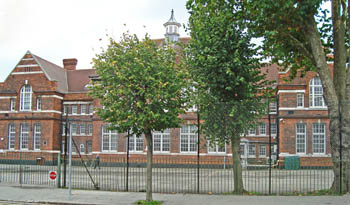
The School became the Croydon Sixth Form College. It is also the home of the Davidson Professional Centre.
The Ecclesbourne Road War Hospital
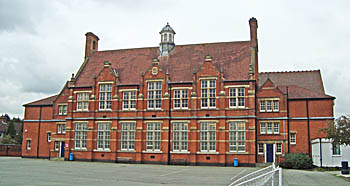
The Ecclesbourne Road Junior and Senior Schools were built in 1900 on a site which had once been gravel pits.
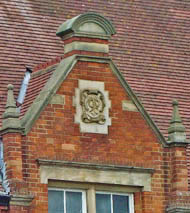
A stylised 1900 stone plaque over the central top window.
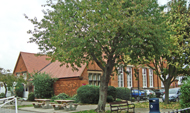

School buildings at the south of the site.
In 1961 the School was renamed the Bensham Manor Secondary School, a community school for children with special educational needs.
Ingram Road War Hospital
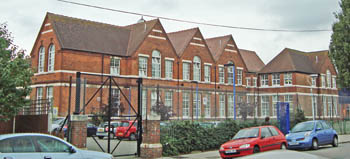
The Ingram Road Council School opened in 1905.

In 1922 it was renamed Ingram Council School.
Today it is St Cyprian's Greek Orthodox Voluntary Aided Primary School, with the entrance for the pupils in Springfield Road.
Stanford Road War Hospital
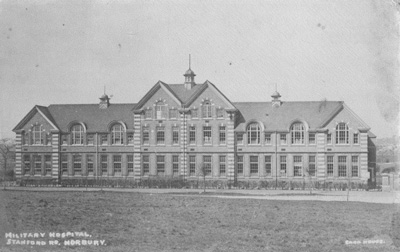
The Military Hospital, Stanford Road, Norbury.
(Photograph courtesy of Mr Colin Taylor.)
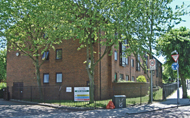

After the war the School opened as Norbury Manor Secondary School.
The buildings were demolished in 1987. Freeman Court, containing sheltered housing for the elderly, now occupies the site.
The Crescent War Hospital
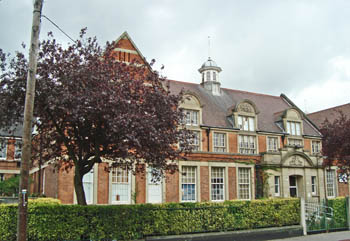
The central building of the School, which was renamed Selhurst Grammar School in 1921.

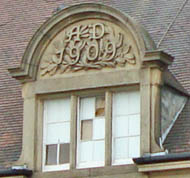
A masonry coat-of-arms for the Borough of Croydon is located above the main entrance, with the motto sanitate crescamus - may we grow in health (left). The coving above the central window bears the date A.D. 1909 (right).
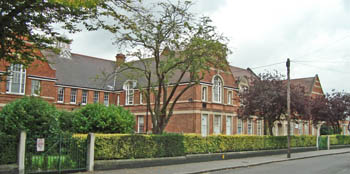
The School buidings are quite extensive. It became the Selhurst Mathematical and Computing Specialist School, but closed in 2008.
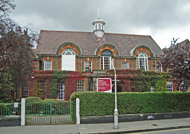
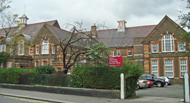
The northern section of the School reopened in 2011 as the Crescent Primary School.
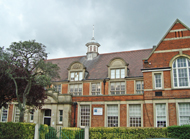
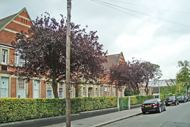
The southern section of the School was purchased by the Performing Arts and Technology School.
Readers' comments
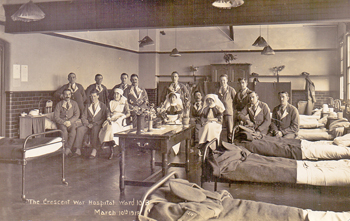
Postcard entitled "The Crescent War Hospitall Ward 10 B, March 10th 1918"
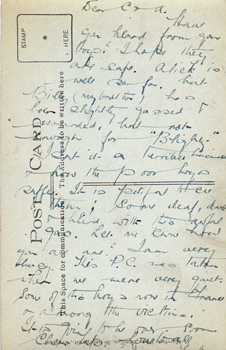
The postcard reads (my interpretation): Dear C & A, Have you heard from your boys? I hope they are safe. Alick is well so far, but Biby (my brother) has been slightly gassed and wounded, but not enough for "Blighty". Isn't it a terrible business and how the poor boys suffer. It is pitiful there for them; some deaf, dumb and blind with this awful gas. Let me know how you all are? I am very busy. This P.C. was taken when we were quiet. Some of the boys now in France and among the victims. It is going to be gas. Soon ........ Love to all, Yrs. M.
(Author unstated) 1917 List of the various hospitals treating military cases in the United Kingdom. London, H.M.S.O.
Bligh S 1994 Croydon in Old Photographs. Stroud, Alan Sutton Publishing Co.
Colyer JF 1916 War injuries of the jaw and face. Proceedings of the Royal Society of Medicine 9, 84-90.
Keatley Moore H. Berwick Sayres WC (eds) 1920 Croydon and the Great War; the Official History of the War Work of the Borough and its Citizens from 1914 to 1919, together with the Croydon Roll of Honour. Croydon, Corporation of Croydon. Reprinted in facsimile (2003) by Naval Military Press.
http://burnleyinthegreatwar.info
http://paperspast.natlib.govt.nz
http://picture.belga.be
www.croydononline.org
www.pikle.co.uk
Return to home page